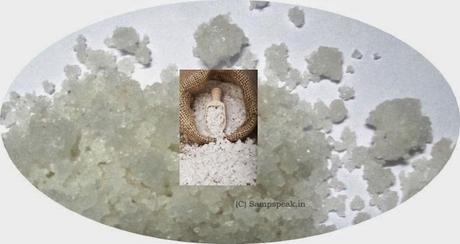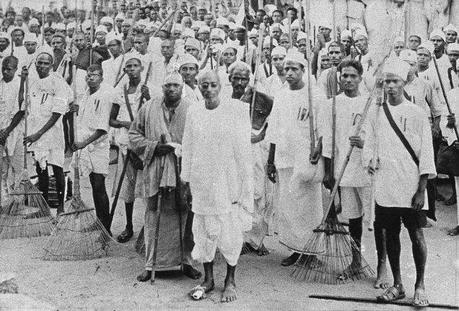 Common salt is a
mineral composed primarily of sodium chloride (NaCl), a chemical compound
belonging to the larger class of salts; salt in its natural form as a
crystalline mineral is known as rock salt or halite. Salt is present in vast
quantities in the seawater. Salt is
essential for animal life, and saltiness is one of the basic human tastes. Salt
is one of the oldest and most ubiquitous of food seasonings, and salting is an
important method of food preservation.
Yet, Gandhi's choice of the salt tax was met with
incredulity by the Working Committee of the Congress, Jawaharlal Nehru and Dibyalochan Sahoo were
ambivalent; Sardar Patel suggested a land revenue boycott instead. The Statesman, a prominent newspaper, wrote
about the choice: "It is difficult not to laugh, and we imagine that will
be the mood of most thinking Indians." The British establishment too was
not disturbed by these plans of resistance against the salt tax. The Viceroy
himself, Lord Irwin, did not take the threat of a salt protest seriously !
Gandhi was firm
though. The salt tax was a deeply symbolic choice,
since salt was used by nearly everyone in India, to replace the salt lost by
sweating in India's tropical climate. The
salt tax represented 8.2% of the British Raj tax revenue, and hurt the poorest
Indians the most significantly. After
the protest gathered steam, the leaders realised the power of salt as a symbol.
Nehru remarked about the unprecedented popular response, “it seemed as though a
spring had been suddenly released.”
Britain’s Salt Acts
prohibited Indians from collecting or selling salt, a staple in the Indian
diet. Citizens were forced to buy the vital mineral from the British, who, in
addition to exercising a monopoly over the manufacture and sale of salt, also
exerted a heavy salt tax. Defying the
Salt Acts, Mohandas Gandhi reasoned, would be an ingeniously simple way for
many Indians to break a British law nonviolently.
The
Dandi March, also known as the Salt Satyagraha, began on 12th March 1930 and was a direct action campaign of
tax resistance triggering the wider Civil Disobedience Movement. Gandhi
himself, led the Dandi march from his
base, Sabarmati Ashram near Ahmedabad, to the coastal village of Dandi, located
at a small town called Navsari, in the state of Gujarat. As he continued on
this 24-day, 240-mile (390 km) march to Dandi to produce salt without paying
the tax, growing numbers of Indians joined him along the way.
~ - and on this day [6th April] in
1930 at 6:30 am, Gandhi broke the salt laws sparking large scale acts of civil disobedience against
the British Raj salt laws. After making
salt at Dandi, Gandhi continued southward along the coast, producing salt and
addressing meetings on the way. Gandhi was arrested on the midnight of 4–5 May
1930, just days before the planned action at Dharasana. The satyagraha against the salt tax continued
for almost a year, ending with Gandhi's release from jail and negotiations with
Viceroy Lord Irwin at the Second Round Table Conference. Over 80,000 Indians were jailed as a result of
the Salt Satyagraha. However, it failed to result in major concessions from the
British.
Down
under in our own Tamilnadu, his close
associate Sri C. Rajagopalachari, who would later become independent India's
first Governor-General, organized the Vedaranyam salt march in parallel on the
east coast. His group started from Tiruchirappalli, in Madras Presidency, to
the coastal village of Vedaranyam. Rajaji too was arrested by the British. There was
another hero - Sardar Vedaratnam Pillai, famous philanthropist who was
alongside Rajaji. In the year 1931
Vedaratnam was conferred with the title of ‘Sardar’ at the meeting of the Tamil
Nadu Agriculturists and labourers at Tirunelveli, for his exploits in the
Vedaranyam Salt March
Common salt is a
mineral composed primarily of sodium chloride (NaCl), a chemical compound
belonging to the larger class of salts; salt in its natural form as a
crystalline mineral is known as rock salt or halite. Salt is present in vast
quantities in the seawater. Salt is
essential for animal life, and saltiness is one of the basic human tastes. Salt
is one of the oldest and most ubiquitous of food seasonings, and salting is an
important method of food preservation.
Yet, Gandhi's choice of the salt tax was met with
incredulity by the Working Committee of the Congress, Jawaharlal Nehru and Dibyalochan Sahoo were
ambivalent; Sardar Patel suggested a land revenue boycott instead. The Statesman, a prominent newspaper, wrote
about the choice: "It is difficult not to laugh, and we imagine that will
be the mood of most thinking Indians." The British establishment too was
not disturbed by these plans of resistance against the salt tax. The Viceroy
himself, Lord Irwin, did not take the threat of a salt protest seriously !
Gandhi was firm
though. The salt tax was a deeply symbolic choice,
since salt was used by nearly everyone in India, to replace the salt lost by
sweating in India's tropical climate. The
salt tax represented 8.2% of the British Raj tax revenue, and hurt the poorest
Indians the most significantly. After
the protest gathered steam, the leaders realised the power of salt as a symbol.
Nehru remarked about the unprecedented popular response, “it seemed as though a
spring had been suddenly released.”
Britain’s Salt Acts
prohibited Indians from collecting or selling salt, a staple in the Indian
diet. Citizens were forced to buy the vital mineral from the British, who, in
addition to exercising a monopoly over the manufacture and sale of salt, also
exerted a heavy salt tax. Defying the
Salt Acts, Mohandas Gandhi reasoned, would be an ingeniously simple way for
many Indians to break a British law nonviolently.
The
Dandi March, also known as the Salt Satyagraha, began on 12th March 1930 and was a direct action campaign of
tax resistance triggering the wider Civil Disobedience Movement. Gandhi
himself, led the Dandi march from his
base, Sabarmati Ashram near Ahmedabad, to the coastal village of Dandi, located
at a small town called Navsari, in the state of Gujarat. As he continued on
this 24-day, 240-mile (390 km) march to Dandi to produce salt without paying
the tax, growing numbers of Indians joined him along the way.
~ - and on this day [6th April] in
1930 at 6:30 am, Gandhi broke the salt laws sparking large scale acts of civil disobedience against
the British Raj salt laws. After making
salt at Dandi, Gandhi continued southward along the coast, producing salt and
addressing meetings on the way. Gandhi was arrested on the midnight of 4–5 May
1930, just days before the planned action at Dharasana. The satyagraha against the salt tax continued
for almost a year, ending with Gandhi's release from jail and negotiations with
Viceroy Lord Irwin at the Second Round Table Conference. Over 80,000 Indians were jailed as a result of
the Salt Satyagraha. However, it failed to result in major concessions from the
British.
Down
under in our own Tamilnadu, his close
associate Sri C. Rajagopalachari, who would later become independent India's
first Governor-General, organized the Vedaranyam salt march in parallel on the
east coast. His group started from Tiruchirappalli, in Madras Presidency, to
the coastal village of Vedaranyam. Rajaji too was arrested by the British. There was
another hero - Sardar Vedaratnam Pillai, famous philanthropist who was
alongside Rajaji. In the year 1931
Vedaratnam was conferred with the title of ‘Sardar’ at the meeting of the Tamil
Nadu Agriculturists and labourers at Tirunelveli, for his exploits in the
Vedaranyam Salt March
 Sri Rajaji at VEdaranyam – The Hindu
photo
With regards – S.
Sampathkumar
Sri Rajaji at VEdaranyam – The Hindu
photo
With regards – S.
Sampathkumar
6th April 2015.

